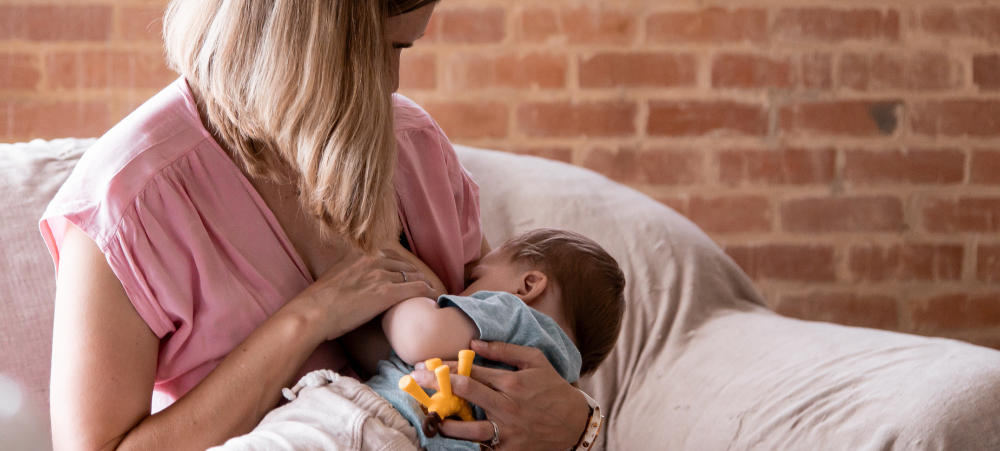Becoming a mom is one of life’s greatest gifts, and whether it is your first or your third time, the feeling of immense joy you experience when you first lay eyes on your baby, is unbeatable. Having said that, many new moms express that these feelings of joy are quickly pushed aside by feelings of complete panic and helplessness when it comes to breastfeeding for the first time.
At first, breastfeeding may seem daunting. As a mom, you may expect it to come naturally. For some moms it does, but for many it requires a bit more hard work. Each pregnancy, birth, and baby are also completely different, which means that just because you had an easy time breastfeeding your first baby, it may not be like that second time round.
So, why do moms breastfeed?

We’ve all heard that breastfeeding gives a baby the best possible start. Breast milk is considered to be the most nutritious feeding option, due to the milk being rich in antibodies that can help little ones fend off infections and bugs. Breast milk is easily digestible and can help to reduce colic if a baby is suffering. It is packed with goodness to help baby grow.
There is also research by The Lullaby Trust that suggests that breastfeeding can help to reduce the risk of SIDS (Sudden Infant Death Syndrome).
The benefits are evidently fantastic for babies, but what about for mum, are there any benefits for her? Well, the answer is yes. Breastfeeding is thought to help to reduce the risk of breast and ovarian cancer and delay the return of periods for a little longer. For mom, breastfeeding helps your womb return to its normal size more quickly and can also help burn the calories, so it can help with post pregnancy weight loss.
It can also mean one less thing to do, as milk is ‘on tap’, meaning no washing or sterilising of bottles.
It is not always that easy though.
Why doesn’t breastfeeding always work?
There are a number of reasons why breastfeeding feels harder for some mothers. Issues brought about by problems with milk supply, poor latch, mastitis (where the woman’s breast tissue becomes painful and inflamed), anxiety, or feelings of being self-conscious about feeding in public can affect a mom’s experience of breastfeeding.
From a more practical point of view, some moms choose to bottle-feed so that they can share the feeding with a partner, have time to recover from birth, or to simply allow them to take a break for work or self-care.
There should be no judgement or feelings of “failure” associated with how a baby is fed – a baby’s nutrition is the most important thing. Every parent is entitled to make their own mind up about how they feed their baby and there are a number of considerations as to why people start, continue or stop breastfeeding.
For those moms who do wish to breastfeed, it is important to not be discouraged if things don’t go according to plan right from the beginning. There is help and resources available that will guide you and address any fears and concerns you may have. With some practice and the right help though, it can be stress-free, relaxing and enjoyable for you and your baby.
Despite all the worries and pressure you may feel to breastfeed, the important thing is to relax and do it your way. You know what is right for you and your baby, so trust yourself and take one step at a time. Don’t compare your journey to the journey of others and listen to your instincts and to your body.
Getting started
Breast milk is free, sterile and packed with antibodies and nutrients to protect baby. Breastfeeding isn’t always easy, however. It can take time for both mom and baby to get the hang of it. Read up on the topic as much as possible while you are still pregnant, especially if this is your first pregnancy. Talk to other moms to find out how they experienced the journey (but do not be discouraged if their breastfeeding journey was unsuccessful, and do not beat yourself up if their journey is easier than yours!). Discuss breastfeeding with your midwife or doctor and ask them all the questions you’ve been pondering over. Knowledge is power and the more you know, the less intimidated you will be when the time comes.
Colostrum
The first milk the breasts produce is a thick golden fluid called ‘colostrum’. It contains concentrated immunity properties to protect and nourish in the first few days of life before the milk supply comes in around day three.
Positioning yourself comfortably
There is no right or wrong way to breastfeed, but both baby and mom must be comfortable in the preferred position. Ask your midwife or health visitor for advice on positions, how to establish feeding or to check on baby’s latch. If you hold an uncomfortable position for too long, you may experience back and shoulder pain, making the next feed even more difficult. Sitting in a reclined position is a preferred choice for many moms.
Baby should be positioned so that their mouth is level with your nipple. Their head should be slightly tilted backwards, and they should not have to turn their head to get into position. Babies tend to find their comfy position by themselves, so pay attention so that you can pre-empt it next time.
Key essentials
Baby needs to be able to root for the nipple and there has to be a good latch to successfully feed. Sit in a comfortable chair with a pillow to support the weight of baby, muslin cloths to clean up milk dribbles and keep a glass of water nearby to stay hydrated.
How to know if they are getting enough
A breastfed baby cannot ever be overfed, so take baby’s lead on when they want to be fed. Look out for signs that your baby may be hungry before they start to cry. When they are hungry, they may open and close their mouth or stick their tongue out. They may also suck on their hand, a blanket or a toy, or may turn their head repeatedly.
A newborn baby will feed little and often, spacing out over time. Mom will often know when to offer a feed based on how her breasts feel – either full or with a tingly feeling. Having said that, it is also important to take the lead from your baby when it comes to feeding times. Though having a rigid feeding time table in place may make your life easier, it will seldom satisfy baby. If baby is showing signs of hunger, do not try push the time out because it’s too soon after the last feed. You may live to regret the repercussions! If baby is asleep and the time has come for their next feed, leave them be. They can feed when they wake up. As much as routine is important, it’s also important to go with the flow, and to take things at a leisurely pace at the beginning.
Expressing
Breast milk can be expressed if a baby will take a bottle. An electric or manual breast pump can be used to help reduce painful engorged breasts that can lead to mastitis, to stimulate milk supply or build up a store of frozen milk.
Taking care of your skin
The skin on the breasts is delicate, and during the course of breastfeeding, you may find the skin becomes very dry or even cracked. This can make breastfeeding a painful experience. There are a number of different ways you can protect and soothe the skin to avoid this from happening. Firstly, do not be tempted to over-wash the area. After each feed, gently pat your breasts down with a soft face cloth or towel. One or two showers a day is more than enough, and be sure to use a gentle moisturising soap.
Bras and clothing may irritate the sensitive skin on the breasts. Whenever possible, allow the breasts to air. Apply nipple creams regularly. These are specifically formulated to be safe for baby so you won’t have to worry about dangerous ingredients.
Effortless multitasking
The time you spend with your baby is the perfect opportunity to bond and take some time to yourself. Try some gentle deep breathing and you could even try doing pelvic floor exercises at the same time that baby feeds to strengthen muscles that are put under a lot of strain in pregnancy and labour. A baby will feed up to 8 times a day in the early weeks, so it acts as a great mental reminder.
Signs to look out for
You will know if things are going well, or if your breastfeeding journey needs some assistance. When baby is feeding well, he or she will suck eagerly. After feeding, they may appear a bit more pink in colour and they will appear drowsy or relaxed. Whilst babies are breastfed you may notice that their nappies are often wet. During the first few weeks they may have between four and eight bowel movements per day, and are likely to urinate regularly. This is completely normal and likely due to their colostrum consumption.
Simple tips for breastfeeding moms
If you’re reading this and trying to persevere, but struggling with breastfeeding, we’re here to help. Here are a few of our tried and tested tips that may help with some of your concerns.
- Try to remain calm. Babies pick up on anxiety and if they are already stressed, it won’t help the situation. A few deep breaths before you begin will lower your heart rate and calm your mind. Our environment goes a long way in setting our mood. Make sure that the spot where you nurse is clean, clutter-free and calming.
- Use nipple shields. Sore, cracked nipples can be very painful, so use the shields to continue feeding whilst any soreness heals.
- Apply lanolin cream. This is liquid gold for sore nipples – it is baby-safe and well worth the money to help with healing.
- Invest in a good nursing bra (or two!). Find one that provides the right support, is comfortable, and easily opens for nursing. They may not be the prettiest bras on the shelf, but they will make your life so much easier.
- Wear nipple pads. These can absorb leakage but they also add a layer between sore nipples and clothing. Remember that leakage is absolutely normal and can happen for any number of reasons, such as if your baby hasn’t nursed for several hours, if you hear a baby cry or even if you think about your baby.
- Stay hydrated. Drink lots of water – hydration is really important to milk production and to prevent headaches.
- Massage lumps. Hand-expressing a little whilst in a hot shower can reduce some of the fullness and those lumps to prevent the build-up of blocked ducts.
Reading about breastfeeding and actually breastfeeding, are two completely different things. Things that should work, in theory, do not always work in real life. Our advice is to ask for help as soon as baby is born. Hospital staff are knowledgeable and will help get you on the right path straight away. If you’re still having difficulty after having left the hospital, a lactation consultant could be the answer. They are even able to visit you in hospital if needed.
Breastfeeding support is out there. For one-to-one help, reach out to health practitioners and midwives. For more general information, find a trusted online portal, or follow the blog section of a brand you trust. Most importantly, be patient with yourself and be kind to yourself. Your body is doing amazing things!
- Co-Sleeping, Cribs, or Sleep Training — What Works Best? - November 10, 2025
- Can Moms Really Afford to Breastfeed? - October 15, 2025
- Lesser-Known Pregnancy Risks That Need To Be Discussed - September 22, 2025





